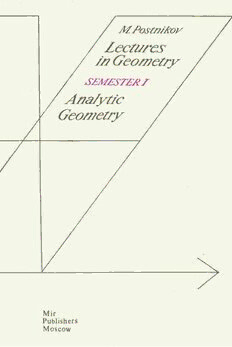Table Of ContentMir
Publishers
Moscow
This textbook comprises lectures
read by the author to the first-
year students of mathematics at
Moscow State University.
The book is divided into two parts
containing the texts of lectures
read in the first and second
semesters, respectively.
Part One contains 29 lectures and
read in the first semester.
The subject matter is presented
on the basis of vector axiomatics
of geometry with special emphasis
on logical sequence in introduction
of the basic geometrical concepts.
Systematic exposition and
application of bivectors and
trivectors enables the author to
successfully combine the above
course of lectures with the
lectures of the following
semesters.
The book is intended for university
undergraduates majoring
in mathematics.
<*Oi 'NIRO'
LECTURES
o v
I N GEOMET
l \ \
SEMESTER I
ANALYTIC
GEOMETRY
M. M. EIOCTHUKOS
JIEKqilH no rEOMETPHH
CEMECTP I
AHAJIHTHHECKAH rEOMETPHH
MOCKBA «HAyKA»
rjiasHan penamuiH $n3HKo*MaTeMaTinecKoft
jTHTepaTypu
M. POSTNIKOV
LECTURES
IN GEOMETRY
SEMESTER I
ANALYTIC
GEOMETRY
Translated from the Russian
by Vladimir Shokurov
MIR PUBLISHERS
Moscow
First published 1982
Revised from the 1979 Russian edition
Ha aufjiuucKOM xattne
© rnaBHan pegaKijiiH <f>nanKO-MaTeMaTniecKOH nuTepaTypu
naAaTenbCTBa «HayKa», 1979
© English translation, Mir Publishers, 1982
CONTENTS
Preface to the Russian edition
Preface to the English edition
Lecture 1
The subject-matter of analytic geometry. Vectors. Vector
addition. Multiplication of a vector by a number. Vector
spaces. Examples. Vector spaces over an arbitrary field
Lecture 2
The simplest consequences of the vector space axioms.
Independence of the sum of any number of vectors on brackets
arrangement. The concept of a family
Lecture 3
Linear dependence and linear independence. Linearly
independent sets. The simplest properties of linear depen
dence. Linear-dependence theorem
Lecture 4
Collinear vectors. Coplanar vectors. The geometrical mean
ing of collinearity and coplanarity. Complete families of
vectors, bases, dimensionality. Dimensionality axiom.
Basis criterion. Coordinates of a vector. Coordinates of
the sum of vectors and those of the product of a vector
by a number
Lecture 5
Isomorphisms of vector spaces. Coordinate isomorphisms.
The isomorphism of vector spaces of the same dimension.
The method of coordinates. Affine spaces. The isomorphism
of affine spaces of the same dimension. Affine coordinates.
Straight lines in affine space. Segments
6 Contents
Lecture 6 54
Parametric equations of a straight line. The equation of
a straight line in a plane. The canonical equation of a
straight line in a plane. The general equation of a straight
line in a plane. Parallel lines. Relative position of two
straight lines in a plane. Uniqueness theorem. Position
of a straight line relative to coordinate axes. The half
planes into which a straight line divides a plane
Lecture 7 63
An intuitive notion of a bivector. A formal definition
of the bivector. The coincidence of the two definitions.
A zero bivector. Conditions for the equality of bivectors.
Parallelism of the vector and the bivector. The role of
the three-dimensionality condition. Addition of bivectors
Lecture 8 71
The correctness of the definition of a bivector sum. The
product of a bivector by a number. Algebraic properties
of external product. The vector space of bivectors. Bivectors
in a plane and the theory of areas. Bivectors in space
Lecture 9 82
Planes in space. Parametric equations of a plane. The
general equation of a plane. A plane passing through three
noncollinear points
Lecture 10 87
The half-spaces into which a plane divides space. Relative
positions of two planes in space. Straight lines in space.
A plane containing a given straight line and passing through
a given point. Relative positions of a straight line and
a plane in space. Relative positions of two straight lines
in space. Change from one basis for a vector space to another
Lecture 11 99
Formulas for the transformation of vector coordinates.
Formulas for the transformation of the affine coordinates
of points. Orientation. Induced orientation of a straight
line. Orientation of a straight line given by an equation.
Orientation of a plane in space
Contents 7
Lecture 12 112
Deformation of bases. Sameness of the sign bases. Equiva
lent bases and matrices. The coincidence of deformabil-
ity with the sameness of sign. Equivalence of linearly
independent systems of vectors. Trivectors. The product
of a trivector by a number. The external product of three
vectors
Lecture 13 123
Trivectors in three-dimensional vector space. Addition of
trivectors. The formula for the volume of a parallelepiped.
Scalar product. Axioms of scalar multiplication. Euclidean
spaces. The length of a vector and the angle between vectors.
The Cauchy-Buniakowski inequality. The triangle inequal
ity. Theorem on the diagonals of a parallelogram. Or
thogonal vectors and the Pythagorean theorem
Lecture 14 133
Metric form and metric coefficients. The condition of posi
tive definiteness. Formulas for the transformation of
metric coefficients when changing a basis. Orthonormal
families of vectors and Fourier coefficients. Orthonormal
bases and rectangular coordinates. Decomposition of posi
tive definite matrices. The Gram-Schmidt orthogonalization
process. Isomorphism of Euclidean spaces. Orthogonal
matrices. Second-order orthogonal matrices. Formulas for
the transformation of rectangular coordinates
Lecture 15 148
Trivectors in oriented Euclidean space. Triple product
of three vectors. The area of a bivector in Euclidean space.
A vector complementary to a bivector in oriented Euclidean
space. Vector multiplication. Isomorphism of spaces of
vectors and bivectors. Expressing a vector product in terms
of coordinates. The normal equation of a straight line in
the Euclidean plane and the distance between a point and
a straight line. Angles between two straight lines in the
Euclidean plane
Lecture 16 160
The plane in Euclidean space. The distance from a point
to a plane. The angle between two planes, between a straight
line and a plane, Detween two straight lines. The distance
from a point to a straight line in space. The distance between
two straight lines in space. The equations of the common
perpendicular of two skew lines in space

